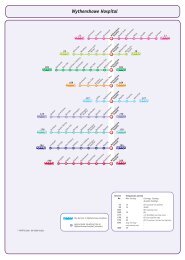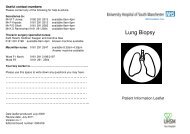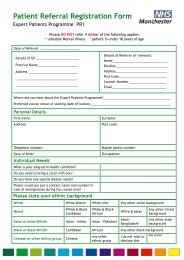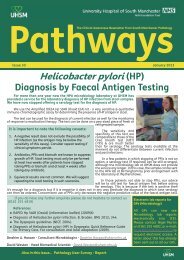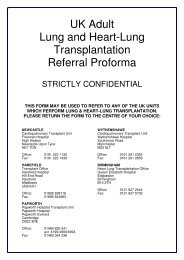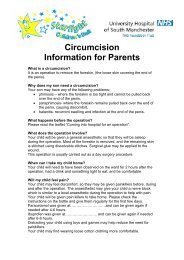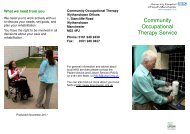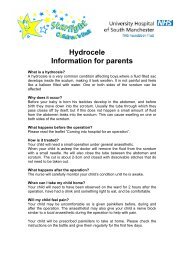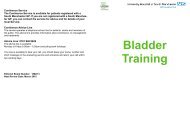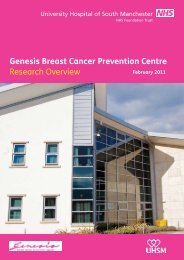A New Beginning 2012-7 - UHSM
A New Beginning 2012-7 - UHSM
A New Beginning 2012-7 - UHSM
You also want an ePaper? Increase the reach of your titles
YUMPU automatically turns print PDFs into web optimized ePapers that Google loves.
What are the risks and complications of Coronary Artery Bypass Grafting?<br />
You will have a chance to discuss your individual risk and possible complications with your<br />
surgeon. CABG surgery, like any other surgery, carries a risk of complications. The risk of<br />
complications varies for each person and will depend on several factors including:<br />
• your age and sex<br />
• whether you are having additional surgery at the same as your CABG<br />
• whether you have diabetes, lung problems, kidney damage or any significant problems<br />
with the circulation to your brain or legs<br />
• the urgency of the operation<br />
• your weight<br />
• whether you are a smoker and/or a heavy drinker.<br />
Your surgeon will take the above factors into account when assessing your individual risk.<br />
Possible complications<br />
• Bleeding – you may need to be taken back to theatre to treat excessive bleeding.<br />
• Infection – this may involve one of the wounds (chest, leg or arm), or the lungs, and will<br />
be treated with appropriate antibiotics depending on the severity of the infection.<br />
• Heart attack – on rare occasions during surgery the heart can suffer a heart attack.<br />
• Kidney problems. Bypass surgery can affect your kidney function. If you have any<br />
problems, you will be referred to a specialist.<br />
• Stroke – which may be temporary or permanent.<br />
A member of the surgical team will ask you to sign a written consent form for the operation to<br />
be carried out. Your surgeon will discuss the risks, benefits and alternatives for you as an<br />
individual. If you have any questions, please talk to the doctor before you sign the consent<br />
form.<br />
What is heart valve disease?<br />
Your heart has four valves. They ensure that blood is pumped in one direction only within the<br />
heart and towards the lungs and body. These valves can be damaged in many ways; for<br />
example be abnormal from birth, after rheumatic fever, from wear and tear or following a heart<br />
attack.<br />
There are two main types of valve problem:<br />
• the valve may become narrowed (called stenosis), which causes a block to normal<br />
blood flow<br />
• the valve may become leaky and allow blood to flow in the wrong direction called<br />
regurgitation.<br />
In both cases the heart has to work harder and eventually surgery may be necessary.<br />
The drainage of blood from the lungs to the heart may be affected. This will result in a build up<br />
of fluid on the lungs and cause breathlessness. The drainage of blood from the rest of the body<br />
to the heart may also be affected causing swollen ankles. Chest pain, palpitations and<br />
dizziness may also be experienced.<br />
How much omega-3 fats do I need to eat each week?<br />
• If you’ve had a heart attack aim for 2 - 3 large servings of oily fish per week<br />
• Everyone else should aim for one serving of oily fish and one serving of white fish per<br />
week<br />
• A serving is roughly 100 -150g (4 - 6oz) of fresh, frozen, or smoked fish<br />
• To help lower salt intake, keep smoked fish to no more than once a week.<br />
I do not eat fish, how do I get omega-3 fats?<br />
• Your body can convert a type of fat called alpha-linolenic acid (ALA), into small amounts of<br />
the more useful omega-3 found in oily fish.<br />
• To help your body convert as much omega-3 fats as possible from plants, it is important to<br />
eat a varied mixed diet with plant rich sources daily.<br />
−<br />
−<br />
−<br />
−<br />
−<br />
rapeseed, walnut, soya, flax or linseed oil<br />
ground or crushed linseeds, flax or pumpkin seeds<br />
unsalted nuts e.g. walnuts, pecans, peanuts, almonds<br />
soya beans and tofu<br />
dark green leafy vegetables, sweet potato and whole grains<br />
• Some foods have omega-3 added to them e.g. eggs, milk, yogurt and yogurt drinks.<br />
Omega-3 contents vary greatly, so check labels.<br />
Should I take omega-3 supplements?<br />
• If you eat oily fish you do not need to take a supplement.<br />
• If you have had a heart attack and do not eat oily fish either:<br />
− Take a prescribed or bought over the counter capsule containing 1.0g omega-3 (EPA<br />
and DHA) daily.<br />
Or<br />
−<br />
If you are unable to take fish oil capsules, try a supplement derived from algae (a good<br />
source of DHA).<br />
If using fish oil capsules, look at the label and check the content of omega-3 fats.<br />
These may be listed as EPA and DHA. Just add the total of both EPA and DHA together to find<br />
the total omega-3 fat content.<br />
Cholesterol<br />
Cholesterol (as discussed on page 40), is an important fatty substance found in every cell of the<br />
body. Too much cholesterol in your blood can increase your risk of heart disease. The most<br />
common cause of high cholesterol levels is eating total fat especially saturated fat.<br />
Fruit and vegetables<br />
Government agencies recommend that you aim to include five portions of fruit and vegetables a<br />
day because of the health benefits this brings. Fruit and vegetables contain vitamins and minerals<br />
and are low in fat. Aim to eat a variety to get the most benefit. These can be fresh, frozen,<br />
canned, dried or as a juice.<br />
8<br />
45





